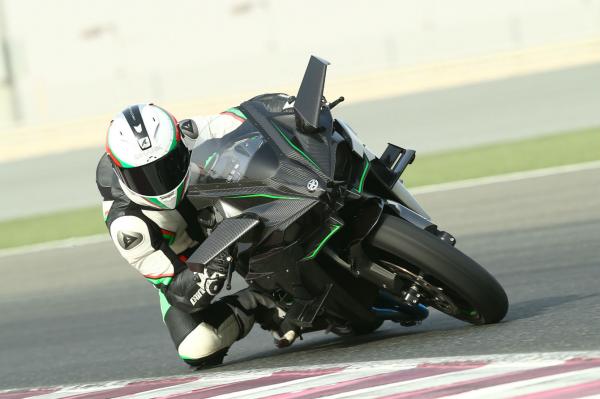
AS a yardstick to measure the comparative performance of different machines, power to weight is a useful tool.
And it’s something that’s been the focus of much attention over the last year. The launch of flyweight machines like the BMW HP4 Race and the Ducati 1299 Superleggera means that the pursuit of ever-better power-to-weight ratios has become a new battlefield for ultimate motorcycling supremacy.
So we’ve scoured the spec sheets to come up with a list of the 10 bikes with the best power-to-weight ratios out there. We’re including track-only bikes like the HP4 Race, with the proviso that you’ve got to be able to buy them. And to add a level of fairness, where a factory track kit comes with the bike (or, as with Honda’s RC213V-S, is sure to be bought by every customer), we’ve assumed it’s fitted.
We’re using dry weight figures to try to give a level playing field, too.
Here goes…
10: Ducati Panigale R: 1.209hp/kg
With all the fuss over the even more powerful Superleggera, the Ducati Panigale R has been pushed from its position as Ducati’s superbike top dog. But it’s still got some impressive numbers. In fact, a few months ago it would have been higher on the list. Ducati used to claim 205hp at 162kg, giving a 1.265hp/kg power-to-weight. It’s recently re-evaluated that power claim, dropping it to 196hp to comply with European testing rules. Still, anything over 1.2hp/kg is pretty astounding. And remember, it’s still got the old 1198cc engine, not the 1285cc motor of the 1299 Panigale.
The old MV Agusta F4 is nearing the end of its life now; it doesn’t meet Euro4 emissions rules and a big revamp is planned. But the top-spec RC model still has plenty to boast about. With the optional exhaust fitted, it manages 212hp, while its dry weight is still impressive even all these years after its launch at 175kg. That gives a power-to-weight of 1.211hp/kg. Enough to scare most of us.
In the past, ‘R’ in a Ducati superbike’s name meant it was a homologation special. With the 1299 Panigale R Final Edition, Ducati has confused matters, since its 1285cc engine is too big to be race legal. Still, it does mean there’s lots of power on offer. 209hp, in fact (and that’s with a road-legal exhaust). Weight is a mere 168kg dry, giving 1.244hp/kg.
In stock form the RC213V-S wouldn’t even come close to troubling this list. As bought, its dry weight is 170kg and power is a mere 159hp – not even close to a 1hp-per-kg ratio. But nobody is likely to leave it like that. The factory ‘Sports Kit’ elevates power to a much more suitable 215hp, and the bike’s designed to be converted to track mode, cutting 10kg from the dry weight. At 160kg and 215hp, the ratio is an impressive 1.343hp/kg.
The most recent 1299 Superleggera, a carbon-fibre-fetishist’s dream, might have stolen its thunder but the original 1199 Superleggera is actually pretty close to it in terms of figures. With its track-only pipe, power is 205hp and dry weight a mere 152.5kg – thanks largely to all-magnesium construction of the frame. That just gives it enough to beat the twice-as-expensive Honda RC213V-S on power-to-weight ratio.
Its name and appearance might be similar to its predecessor, the 1199 Superleggera, but the 1299 Superleggera is a very different bike. The all-carbon frame, swingarm and wheels mean it’s a high-tech beast, and the engine is a highly-tuned version of the ultimate 1285cc Superquadro V-twin. With the track-only pipe, it hits 220hp, and dry weight is 152kg with the 4kg-lighter-than-stock race exhaust. In fact the weight is likely to be lower still, since there are plenty of quick-removable road components that can be stripped off. The fourth Panigale derivative to make the top 10, it’s also the ultimate one. What will Ducati’s new V4 be able to achieve?
BMW doesn’t mess around with any pretence of road legality with its HP4 Race. The clue’s in the name. But like the 1299 Superleggera it’s a celebration of carbon fibre, with the whole frame made of the stuff. That contributes to a dry weight of only 146kg. Power, at 215hp, is also impressive. Less impressive is the fact that BMW recommends replacing the entire engine every 5000km! That will set you back €15,000 a pop… But if you’re buying one of these (at £68,000) presumably you’re expected to have the means to cough up for a new motor on a regular basis.
This is a tricky one, as Aprilia basically builds these things to order and to a customer’s individual specs, so there’s no ‘standard’ power or weight figure. For the top-spec FW-GP, the firm just claims ‘more than 250hp’ from an engine that’s basically the old-spec MotoGP Aprilia motor. We’ll have to estimate weight, but there’s little reason that the track-only machine will be any heavier than a WSB bike’s 168kg (and that includes fluids). Let’s be conservative and estimate the FW-GP at 165kg dry. It might actually be less than that, and might have more than 250hp… But even with those figures it’s easily in third place.
Does the Suter qualify for this list? Given that anyone can order one, and the firm says it’s making 99 of them, we’ll take it at face value and let this two-stroke track tool in. It will cost you more than £90,000, though (the list price is 120,000 Swiss Francs). Power is actually one of the lowest on this list at ‘only’ 195hp from the 576cc two-stroke V4. But weight is where the Suter wins – just 127kg dry…
The road-going Kawasaki H2 doesn’t come close to getting into this top 10, but the track-biased H2R makes the number 1 spot. We’re being a little generous here and using Kawasaki’s 326hp claimed figure, which includes the ram-air effect at high speed. But even with the 310hp that it claims to get stationary, it would still be number one. We are also having to estimate the bike’s dry weight, as Kawasaki only quotes a ‘curb’ figure (216kg). Dry weight will usually be around 20-25kg less, depending on the vehicle, so we’re using a 196kg estimate to reach the 1.663hp/kg that puts the H2R into the top spot.

